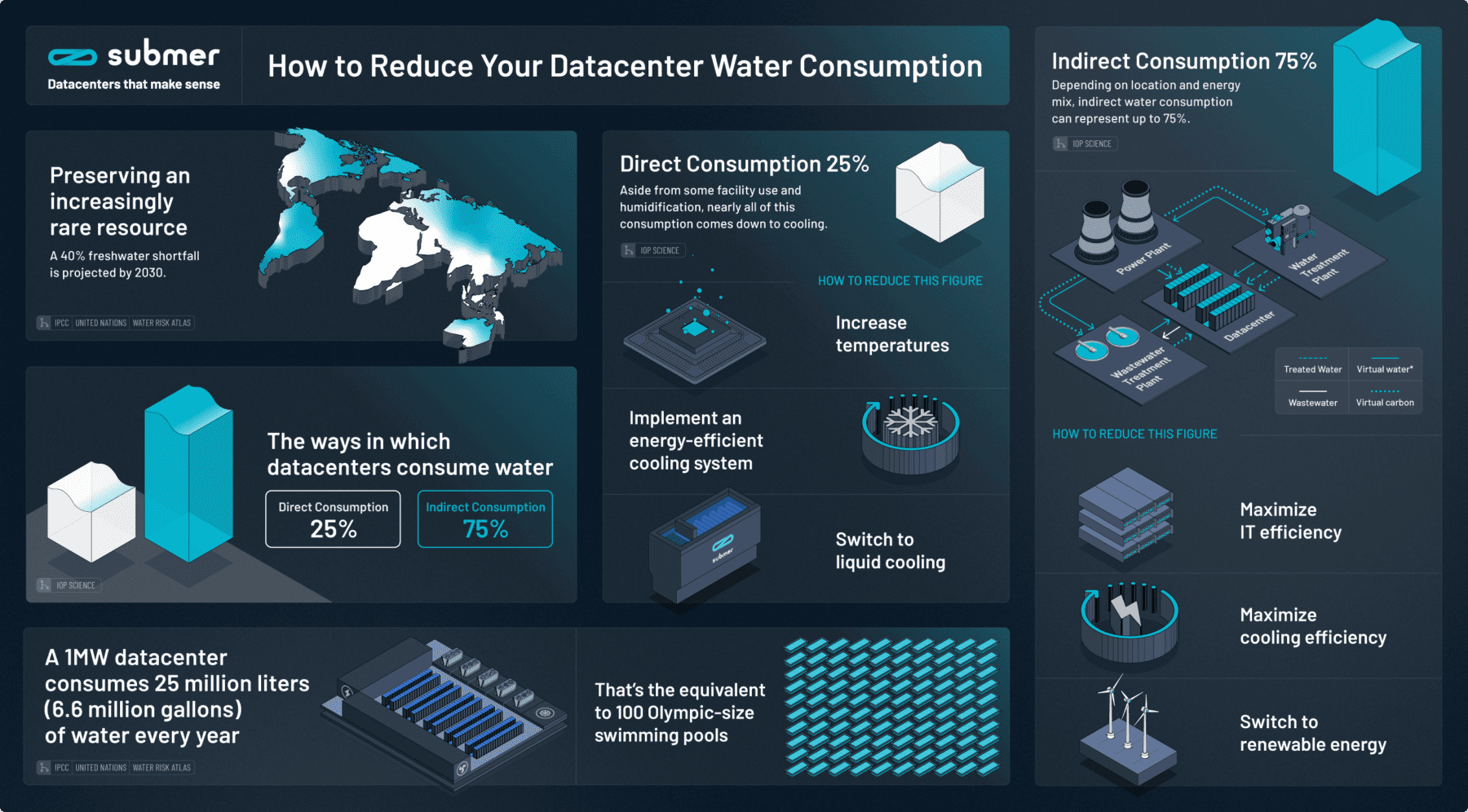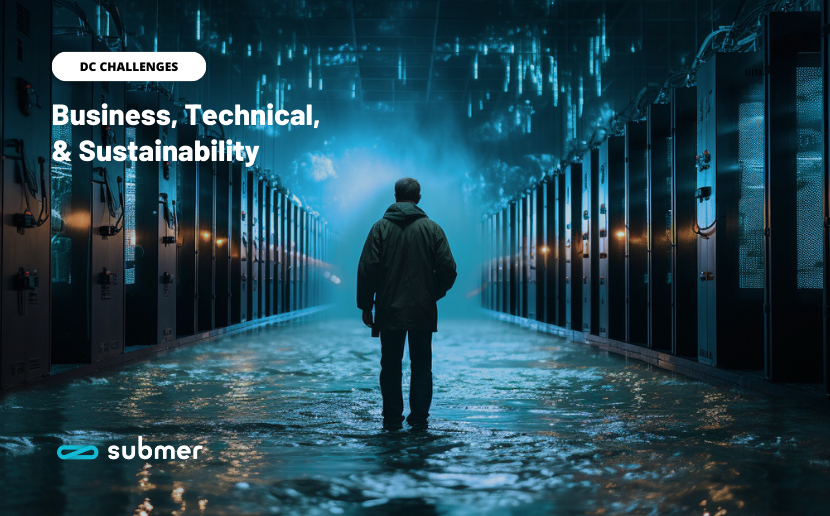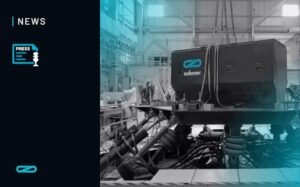We sat down with the executive team of Submer to grill them on the datacenter challenges we’re currently faced with and where they see the industry is headed. We covered what we believe to be the biggest obstacles facing the industry this year from business, technical, and sustainability perspectives. Can immersion cooling check all the boxes for TCO, density, and sustainability? Let’s find out!
The 6 Major Challenges Datacenters Face
With the market teeming with options, workload demands evolving, and sustainability regulations on the rise, it’s never been more important to choose the right cooling solution for you. We’ve compiled the most pressing datacenter challenges for 2024 to guide you on your way to more efficient and sustainable cooling.
1. An influx of cooling options on the market
The market is now flooded with cooling solutions. Our advice for someone just starting their liquid cooling journey is to prioritize your Total Cost of Ownership (TCO), which depends on a number of different factors including location, equipment, IT layout and capacity, ESG, and financials.
Immersion cooling is the most compelling solution in this case and is profitable from day 1. For example, for greenfield builds, less mechanical infrastructure means a lower CAPEX and savings on water and energy result in a lower OPEX.
As far as what makes us unique in the immersion cooling market, we believe that our history of innovation and expertise, our solid ecosystem and interoperability makes us stand out and ensure that we provide long-term viability.
2. Minimizing Water Usage
As pressure from governments and regulations mounts, datacenters now have no choice but to decrease their water consumption to a minimum or even go completely waterless. With the yearly consumption of a 1MW datacenter being 6.6 million gallons (Nature), this presents quite the challenge.
With our immersion cooling solutions, dry coolers and closed-loop water circuits mitigate water wastage. Plus, with massive amounts of MWs being deployed, you can capture the waste heat from your deployed MWs and put it to use in applications across industry, housing, and greenhouses.

3. Density on the Rise
Density’s relentless rise and the subsequent ability to support Moore’s Law (Investopedia) have been the main challenge for the datacenter industry and this year is no different. With CPUs going from 200W to 400W and GPU roadmaps increasing from 600W/700W to 1200/1400W, we’ve reached the point of no return for air cooling.
With our recent innovation of the Forced Convection Heat Sink (FCHS) with Intel, we’re well on the way to cooling more than 1000W+ TDP. Our goal here was to demonstrate the technological runway for immersion cooling and that it covers all components other than CPUS, including GPUs and DIMMs. Immersion cooling is a future-proof investment. While tackling the density of the chip, it in turn makes datacenter buildings denser and more compact.
“An immersion heat sink utilizing forced convection is a key innovation in taking single-phase immersion cooling beyond the current barriers allowing single-phase immersion not only to be a solution of today but also a solution of the future!”
Mohan J Kumar, Intel Fellow
4. Finding a Flexible Solution
While AI is driving a lot of demand, it still represents a small percentage of workloads overall. The majority is in fact general compute and distributed heat flux workloads where a lot of memory is required.
The no-brainer approach to tackling these issues that arise from AI and increasingly hot GPUs is Direct Liquid Cooling (DLC); while this technology has been on the go for a long time and seems like an easy one to operate, we believe that immersion cooling has more strengths for supporting these aforementioned workloads. For example, DLC faces more challenges when it comes to distributed heat flux workloads.
By embracing the dynamic infrastructure of immersion cooling, datacenter operators future-proof their facilities and keep up with evolving workload demands.
5. Climate Resilient Datacenters
With ambient temperatures rising (BBC News) and heat waves becoming more prominent, downtime in datacenters is becoming a more common, long-term issue. Datacenters have no choice but to operate at higher environmental temperatures, complicating the cooling process, and site selection becomes more restricted.
Immersion cooling is resilient to high temperatures. In fact, it lowers your operational costs and can repurpose waste heat for external applications that align with sustainability goals. As an Article 9 company (Deloitte), Submer is making a substantial contribution to global objectives on sustainability – the faster we grow, the greater the positive impact we have on the industry and the planet!
6. Sustainability Regulations
Stringent regulations to minimize environmental impact are popping up everywhere. While focuses differ by region, some major sustainability regulations include:
- Corporate Sustainability Reporting Directive (CSRD): A new EU legislation requiring all large companies to publish regular reports on their environmental and social impact activities.
- Energy Efficiency Directive (EED): Datacenters above 500kW need to annually report on their environmental performance as a result of their energy consumption, cooling efficiency, water usage, etc. Datacenters with a total rated energy input over 1MW will also need to recover waste heat or prove it’s not possible.
- California’s Emissions Disclosure Law (SB 253): Under this new law, datacenter operators are required to measure and report their emissions through the use of standardized methods and tools and report annually to the California Air Resources Board. This data will be publicly available, allowing consumers, investors, and regulators to compare emissions across companies and sectors.
With immersion cooling, you can count on the optimization of water, infrastructure, energy and circularity.
Datacenter Challenges: How Do Things Compare to 2023?
Two out of three of our datacenter challenges from last year of increasing chip density, a lack of resources, and conscious consumption come under the same umbrella. While the landscape has evolved yet again, the ability to be agile and accommodating for a rise in density continues to be a top priority for datacenter operators. Immersion not only meets the demand for high-density but does so with a minimal environmental footprint. Also mentioned last year, conscious consumption remains a challenge, and now governments are keeping an eye on things. Immersion cooling is gaining traction for its sustainability credentials and its use of closed-loop water circuits to repurpose waste heat.
While a lack of resources, such as power and water, was a concern in 2023, immersion cooling is the strategic choice for optimizing their use. The newcomer for 2024 is then the influx of cooling solution, which is something that we believe is best answered with TCO calculations.
These datacenter challenges are all interconnected, and so too are the solutions. Immersion cooling is not just a quick fix but instead a solution that evolves alongside your datacenter under a planet-friendly framework.
Looks like it’s time to take the plunge into immersion…



